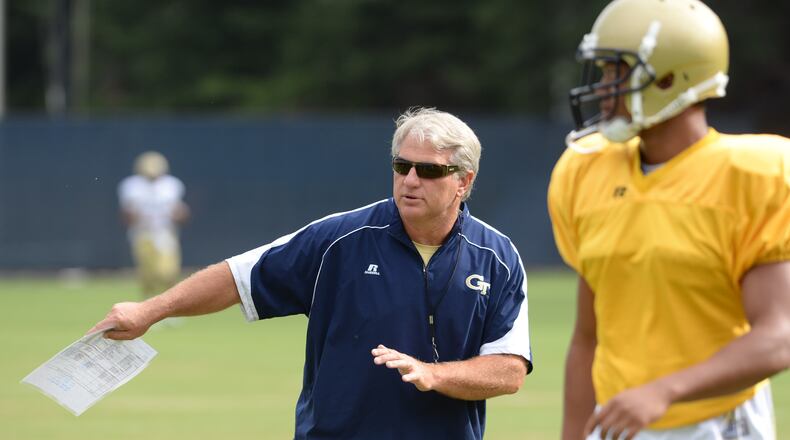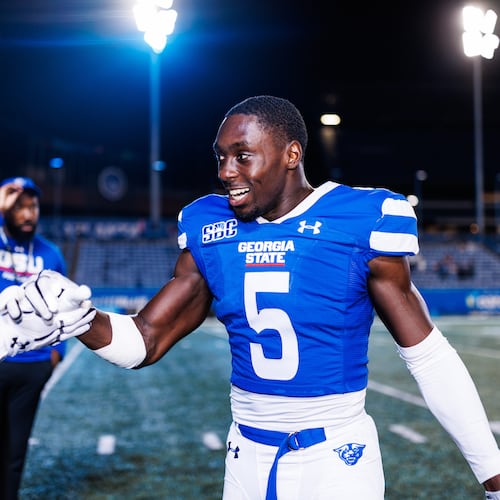Though there’s nothing he can do to create turnovers, Georgia Tech defensive coordinator Ted Roof said it’s still frustrating that his players haven’t been fortunate enough to cause more of those momentum-changing plays.
Tech has forced six turnovers this season, including only three in the past six games. The Yellow Jackets are minus-2 in the category, tied for 86th among FBS teams, with Duke coming to Bobby Dodd Stadium on Saturday.
“Some years are just like that and some years aren’t,” Roof said. “We aren’t coaching it any less hard than anywhere I’ve been.
“If I had an answer I’d give it to you. Better yet, we’d do it.”
To emphasize the fickle nature of creating turnovers, in 1999, Roof’s first season in his first stint as Tech’s defensive coordinator, the Jackets finished last among 114 FBS teams, with a turnover margin of minus-12. They had 12 takeaways.
The next season, the Jackets finished No. 2 at plus-18 with 30 takeaways. The next season, the Jackets found equilibrium at No. 55 at plus-1 with 22 takeaways.
The margins haven’t been as scattered in his second stint as Tech’s defensive coordinator, but are hard to explain. In 2013, Tech was No. 85 at minus-4 with 20 takeaways. In 2014, Tech was No. 14 at plus-11 with 29 takeaways and last season Tech fell back to tied for 105th at minus-7 with 17 takeaways.
With six takeaways this season, the Jackets are on pace to create only 10.3 takeaways in 12 games. It would be the fewest takeaways for a Roof-coached defense on the FBS level. His defenses have averaged 23 takeaways per season, with a low of 12 in 1999 and a high of 31 when he was at Minnesota in 2008.
“Don’t know,” Tech coach Paul Johnson answered when asked why there are so few turnovers if the coaching staff is doing the same drills that seemed to work so well in 2014.
When asked if he had any theories, Johnson said, “Nope. Not really,” before saying that it helps to have more tacklers around the ballcarrier.
Why aren’t there more?
Roof has a theory: the proliferation of spread and spread-option offenses.
Many of the ACC teams prefer to run the spread option that is en vogue in college football. The offense is designed to create one-on-one matchups, which can make it difficult for players on defense to gang tackle because so many aren’t near the ball.
“You have to tackle in space, and the first guy there has to make sure that he gets him down,” Roof said. “Anytime you have overlap you have a better chance to get a takeaway.”
The players understand the correlation between creating turnovers and improving the chances at winning. Defensive lineman Patrick Gamble said if they can create some, not only will it give the offense more chances to score, but it will create positive momentum. Once that gets going, it can be hard to slow down.
“We just have to keep trying,” Roof said. “If you stay after it and stay after it one can lead to two, two can lead to three and so on and so on. That’s what happened in ’14 and what happened at some other places.”
Turning around turnovers
A look at the turnover margins for Ted Roof-coached defenses on the FBS level:
Georgia Tech (DC)
1999: No. 114 in FBS with a turnover margin of minus-12 with 12 takeaways and 24 giveaways.
2000: No. 2 with plus-18, 30 and 12.
2001: t-No. 55 at plus-1, 22 and 21.
Duke (DC)
2002: t-No. 49 at plus 2 with 25 and 23.
2003: t-No. 41 at plus 4 with 21 and 17
Minnesota (DC)
2008: No. 16 at plus-12 with 31 and 19
Auburn (DC/LB)
2009: No. 58 at plus-1 with 24 and 23
2010: No. 33 at plus-5 with 22 and 17
2011: No. 44 at plus-2 with 23 and 21
Penn State (DC)
2012: No. 22 at plus-9 with 22 and 13
Georgia Tech (DC)
2013: No. 85 at minus-4 with 20 and 24
2014: No. 14 at plus-11 with 29 and 18
2015: t-No. 105 at minus-7 with 17 and 24
2016: t-No. 86 at minus-2 with 6 and 8 through seven games
About the Author
Keep Reading
The Latest
Featured


